Continue your way on the boulevard towards Vierville-sur-Mer
After a couple of hundreds meters (orientation point:
a short distance after the tenniscourt) you'll find on the left the marker for the first American cemetery on French soil.
Later the bodies were brought to the American National Cemetery, near Colleville-sur-Mer.

This monument marks the site of the first American cemetery
6 JUNE,
1944, 06.36 HOURS, OBJECT:
OMAHA BEACH, "DOG" SECTOR,
VIERVILLE-SUR-MER
The 116th Infantry Regiment (29th Div.) had the sector 'DOG', running from St. Laurent-sur-Mer
to Vierville-sur-Mer, and the 16th
Infantry Regiment (1st Div.) got 'EASY' and 'FOX', in front of Colleville-sur-Mer, as their objective.
From the
start everything goes wrong, such as the DD tanks, they were
dropped way too far out at sea to reach the beach (only five of them made
it). Even the air bombardment, to soften the German defence, had
failed, the bombs were dropped too far inland. The well trained German 352nd Division held their fire
until the landing craft reached the beaches.
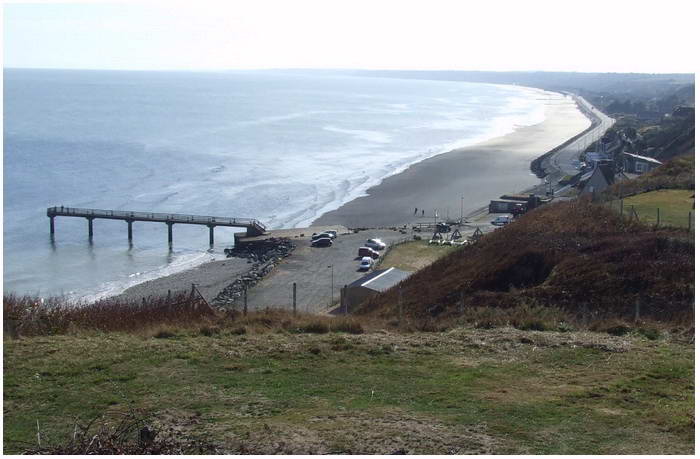
From the dunes at
Vierville-sur-Mer you'll have a good view over the
beaches.
When the ramps
fell of the landing craft all hell broke lose. In shear panic
soldiers jumped over the side of the crafts and many drowned
under their heavy packing. Thirty men from LCA (Landing Craft
Assault) No 105 were all killed instantly by
machinegun fire. Within 10 minutes Company A of the 116th Inf.
Reg. Lost all their officers and the men of the first wave was
not a fighting unit anymore, they became a rescue unit that
tried to safe their comrades from the boiling bloody sea.
116th was part of the 29th Division of the National Guard
Division. Owing to this the 116th was one big club of friends,
a lot of them knew each other from when they were kids. From
Company A, B and D of the 1st Battalion all the recruited men
came from Virginia, from places like Bedford, Lynchburg and
Roanoke. From Bedford alone, a small town with just 3000
inhabitants, 23 young men died at OMAHA. Also three 'sets' of
brothers lost their precious life on this beaches.
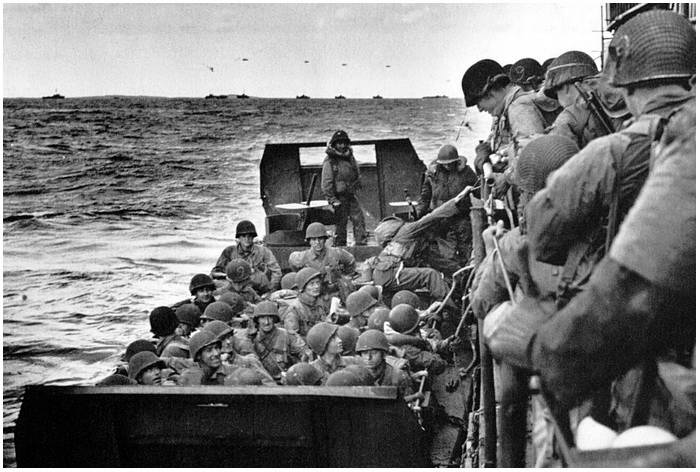 Getting into the wobbly wooden LCVP for Omaha Beach,... and (below)
go for it,..!
Getting into the wobbly wooden LCVP for Omaha Beach,... and (below)
go for it,..!
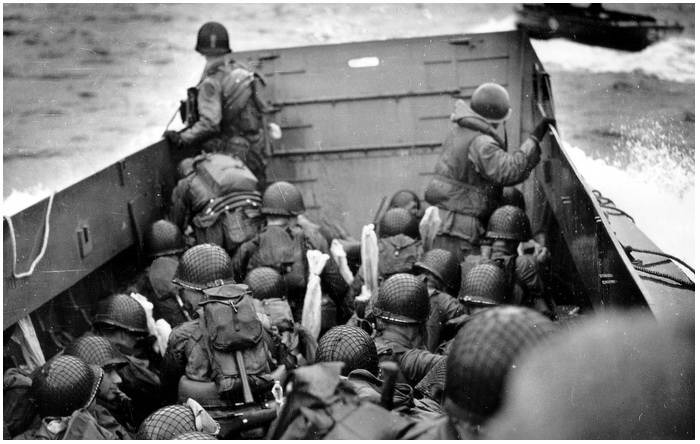
The landing on the beaches was done with incoming tide. During the waves of fighting forces storming the
beach, it became also crowded with vehicles (which were put out of action as soon as they hit the beach).
It was utterly chaos. The ‘Exit DOG-1’ at Vierville-sur-Mer was blocked by an enormous concrete wall but
could not be penetrated because of the constant shelling by the Germans. The USS Texas used her huge
guns in trying blowing a gap into it, but to no avail. The anti-tank wall was breeched around 17.00
hours when it was blown by engineers.
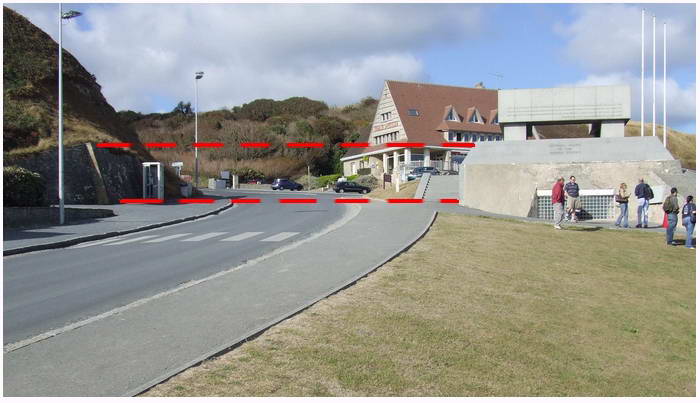 The red line marks the position of the concrete anti-tank wall
The red line marks the position of the concrete anti-tank wall
Under protection of bulldozer, charges of TNT and C4 were placed at the wall. Other then the plaque on the wall suggests, not the 121st Engineer Combat Battalion (ECB) was responsible for this, but the 147th ECB (according to the veteran Don 'Ducky' Robertson ).
The position where the anti-tank wall once was, between the cliff wall and the casemat of Wn 72,
is now marked with a bronze plaque. In this casemat you may find the 8,8cm gun that on D-Day played
havoc on the American troops.
 The bronze plaque on the spot where the concrete wall once was.
The bronze plaque on the spot where the concrete wall once was.
Vierville-sur-Mer was a heavy defended place. Not only the exit was blocked, but also some
strongpoint’s defended this place, such as Wn 72 and, a couple of hundred meters to the west, Wn 73.
If you stand at Wn 72, you can see the dark square of a bunker against the cliff which had once a 7,5cm gun in it.
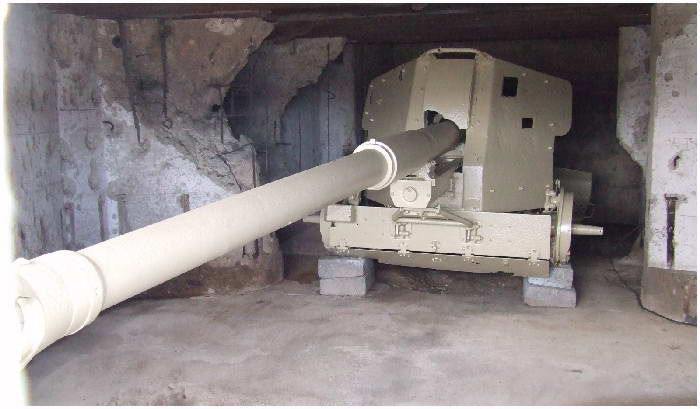 The 8,8cm PAK 43/41 gun is still in it’s casemat of Wn 72
The 8,8cm PAK 43/41 gun is still in it’s casemat of Wn 72
Wn 71 is positioned global above the bronze plaquet to commemorate the destruction of
the concrete wall. An interesting piece of bunker of Wn 71 can be found when you head for
Vierville-sur-Mer on top of the cliff. Just as you pass the corner, look left to the top
of the cliff for the machinegun position which is integrated into the cliff. It is possible
to visit more of Wn 71, go into the suburb of Vierville-sur-Mer and walk to the edge of
the cliff. But this is only for the diehard who wants to see everything.
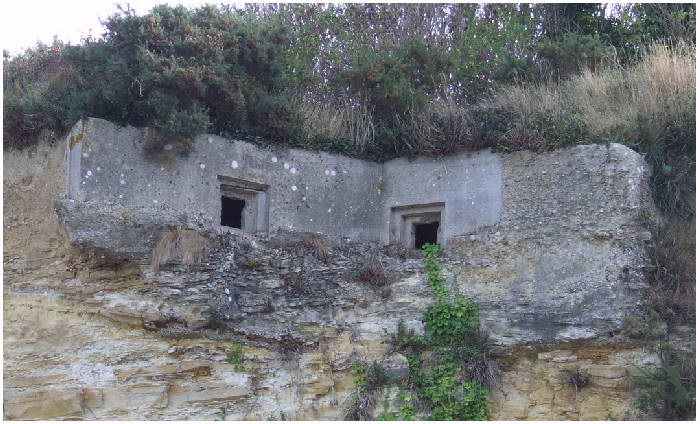 The interesting position of the machinegun of Wn 71
The interesting position of the machinegun of Wn 71
This is also the case when you want to visit Wn 73. There is not much left, and one have to ask
itself, is it world while to risk the struggle? But for the one who has to see all the remnants,
it can be satisfying. Especially the view from the little casemate which housed once a 75mm gun,
towards DOG-Green. In this casemate there is still a painting of the former target, the beach,
visible (next to the impact of a grenade).
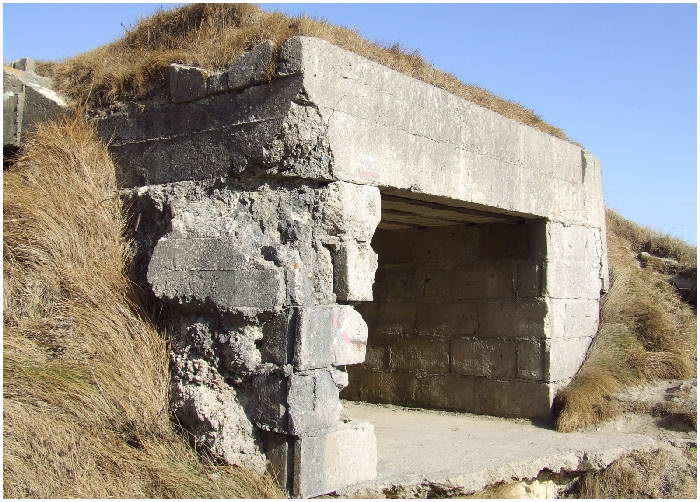 The most important casemat of Wn 73, for 7,5cm gun
The most important casemat of Wn 73, for 7,5cm gun
Looking out over Omaha Beach, sector 'DOG'
When you climb further on into Wn 73, you come across a interseting bunker.
This one has its lookout not towards the beach, but looks towards the church of
Vierville-sur-Mer. In this sector, behind this bunker, there was also the, so called,
‘strong house’, which was an objective for the Rangers. The last pieces of this ruin
were torn down in 1990. There are still some bricks and stones left, and a small pillbox.
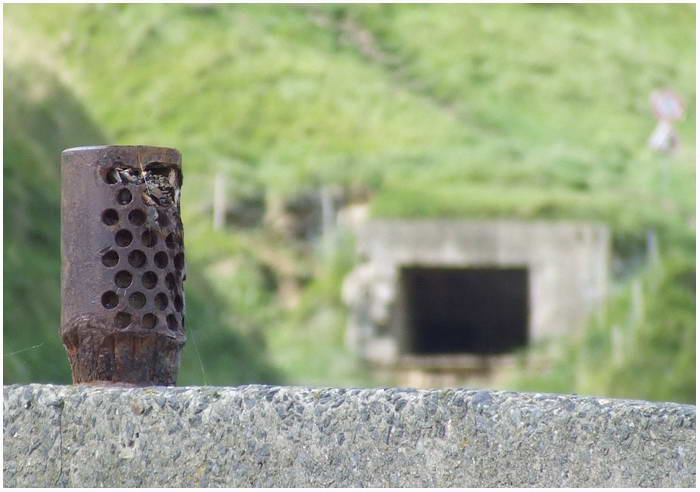 The muscle brake of the 7,5cm gun, from the casemate
in the rear, of Wn73
The muscle brake of the 7,5cm gun, from the casemate
in the rear, of Wn73
can be found embedded into the seawall (and is in use as an astray)
When you return from Wn 73, you can search for a small piece of history, which most
visitors walk past. In the concrete seawall (near the entrance to boardwalk/remnant
Mulberry harbor) you can find the muscle brake of the 7,5cm gun from the casemate of Wn 73.
The unknown visitor thinks that this is an astray!
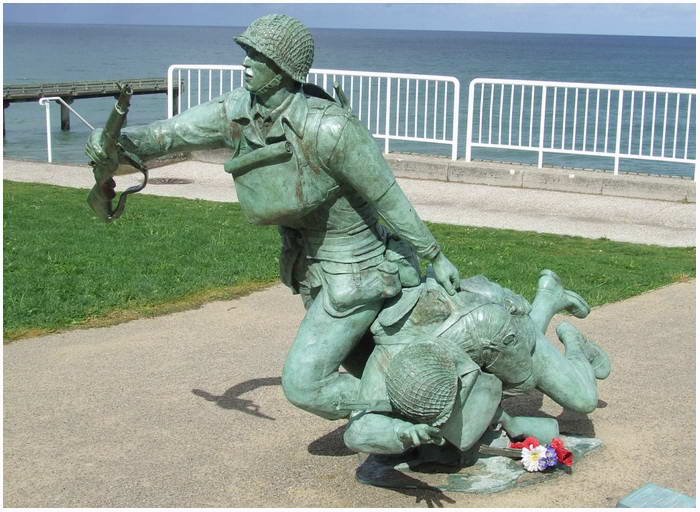 In 2014 this sculpture, 'Ever Forward', was erected in 'Exit DOG-1'
In 2014 this sculpture, 'Ever Forward', was erected in 'Exit DOG-1'
In 2014 a new sculpture was placed near Exit DOG-1’, with the name ‘Ever Forward’. It shows
a soldier who pulls another soldier onto the beach. It is an extra monument for the men of
29th Infantry Division, and specific the 116th Infantry Regimental Combat Team. The whole
area of Vierville-sur-Mer is littered with remnants of D-Day. At low tide,
for instance, some pieces can be seen of the Mulberry ‘A’ harbor. On the next page some more
on this sector, Omaha Beach.

Wn 72, the casemat for the 5cm, Then and Now
(Above: as a anchor for a anti-aircraft barrage balloon)
CLICK ABOVE FOR MORE ON
Omaha Beach and
the surroundings
of Vierville-sur-Mer
|